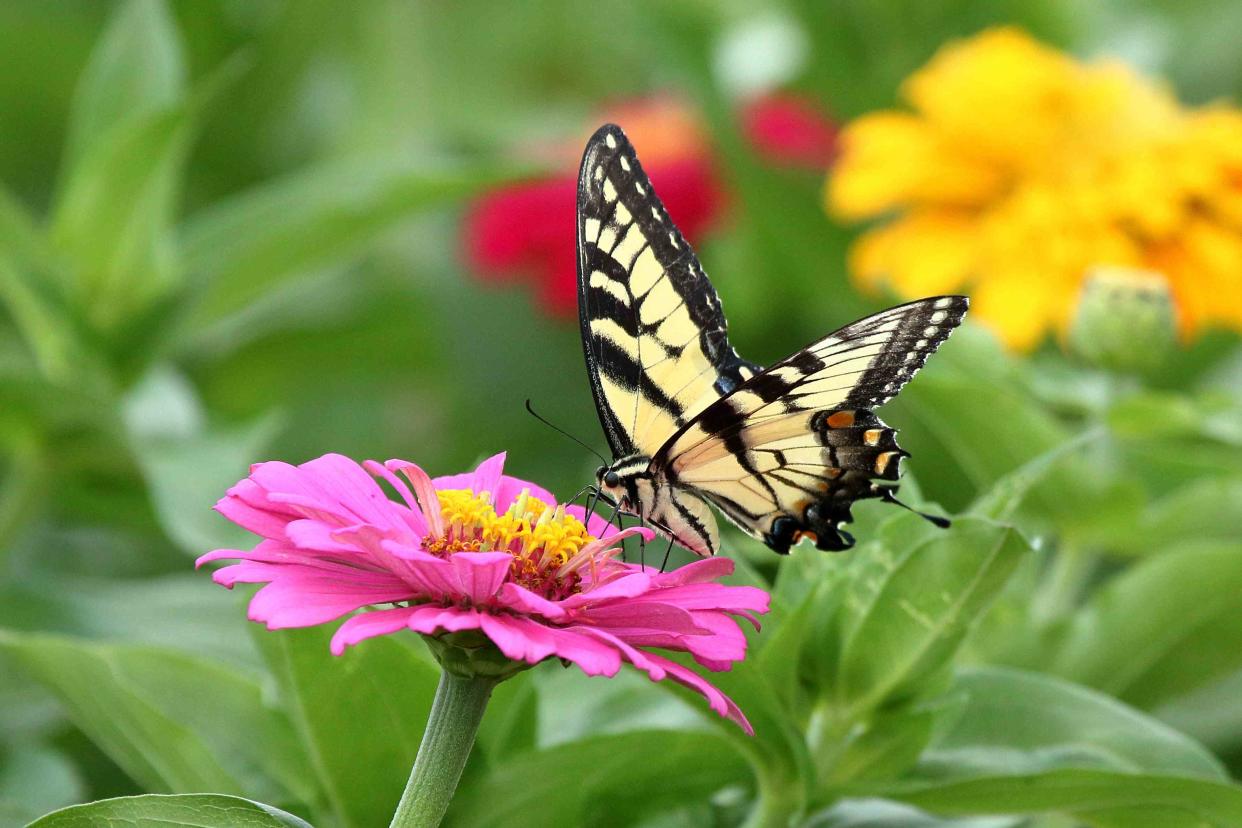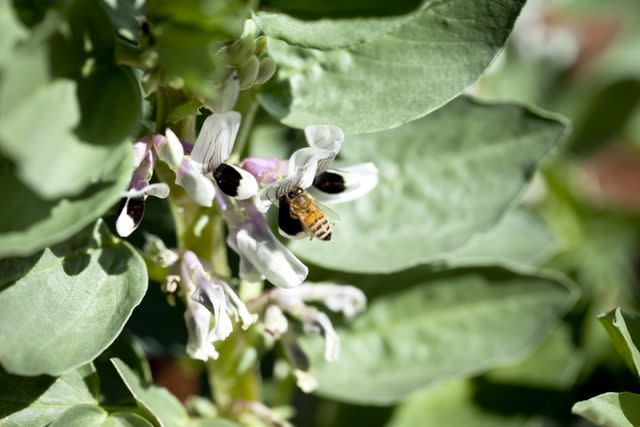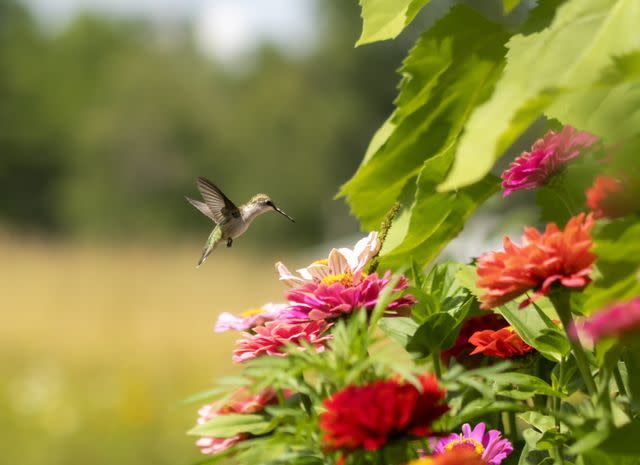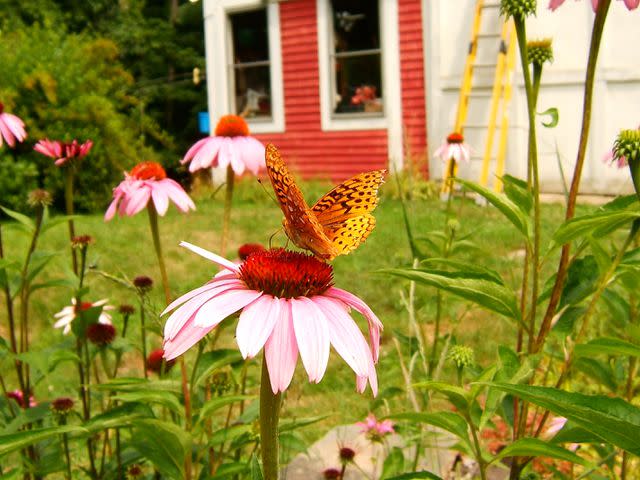Creating Your Own Pollinator Garden Is Easier Than You Think—Here's How

MelodyanneM / Getty Images
Creating your own pollinator garden does more than just encourage beautiful-to-look-at butterflies to visit your yard. Increasing habitat destruction and widespread pesticide use are resulting in dramatically dwindling pollinator populations. And with an estimated one out of every three bites of food we eat depending on pollination for production, why wouldn’t we do whatever we can to boost their numbers?
Pollinator gardens are simple to set up, offer year-round interest, and provide shelter and built-in buffets for birds, bees, and other beneficial insects.
Learn how to make a pollinator garden that supports plant reproduction and biodiversity by picking the right flowering species and providing proper care.
Find a Location
You don’t need a lot of space to create a pollinator garden. Even pots on patios can pull in the pollinators. However, planting in the sunniest spot in your yard is best, as bees and butterflies need warmth to eat and be active. They also appreciate a sheltered site. Too much wind can make flying and landing on those nectar-filled blooms a challenge.
Want more gardening tips? Sign up for our free gardening newsletter for our best-growing tips, troubleshooting hacks, and more!

Jenny Dettrick / Getty Images
Choose the Right Plants
The key to a thriving pollinator garden is picking a selection of low-maintenance, hardy, native plants adapted to thrive in your yard conditions. Don’t just fill your borders with one or two summer-blooming species.
Create a mixed mini-meadow that flowers successively from early spring to fall. The different bloom timings, colors, shapes, and heights will attract more pollinators and provide nourishing nectar for longer. Don’t forget to include some plants that act as caterpillar hosts, too.
The species you should choose depends on the conditions and the types of pollinators in your region. Your local nursery can offer advice on practical, native, nectar-filled favorites. However, some popular plants to attract butterflies, bees, and other pollinators to your gardens include:
Bee balm (Monarda)
Attract Certain Pollinators
Below are some of the most common and beneficial pollinators you can seduce with your plant selection.
Bees: You’ll want to focus on attracting bees to your yard. There are thousands of species in North America and these buzzing bugs are the most effective and important pollinators.
Butterflies: Bees might be more efficient when moving pollen around. However, butterflies are still a beneficial, beautiful addition to any garden. They can reach deep into long blooms, and caterpillars are a valuable food source for other wildlife.
Hummingbirds: Watching these prolific pollinators flit continuously from one bloom to the next is a relaxing way to connect with nature. Vibrant red native species are great for attracting hummingbirds to your yard.
Moths: Your pollinator garden can continue working through the night if you plant blooms to attract nocturnal moths. Moon-reflecting white flowers often draw these bugs in.

Sandra J / 500px / Getty Images
Choose Seeds or Seedlings
When planting your pollinator garden, if you want to offer a same-season nectar fix, it’s best to start with seedlings. However, sowing seeds is a more economical option when you're on a budget, especially if you plan on covering a large space. It’s just that you and the pollinators will have to be patient and wait longer for them to bloom. While starting from seed can be more tricky, native plants often grow more readily from seed than non-native species.
Plant the Garden
Your pollinator garden planting schedule depends on whether you're starting from seed and the species you select, but it will usually begin in early spring or fall. If you don’t have bare soil patches to plant it, you might need to remove an area of lawn first.
Fortunately, native plants are hardy species that often survive in poor sites. However, if you’ve struggled to grow flowers in your chosen spot previously, do a soil test to ensure it isn’t lacking in essential nutrients.
Arranging plants in clumps makes them attractive to pollinators and it makes it easier for them to flit from one bloom to the next while feeding.
Water Regularly
Native plants often require less irrigation than non-native species. However, to encourage bountiful blooms, you’ll want to regularly water when starting seedlings to help the roots establish and during the hot summer season and periods of drought.
Adding a water source, like a DIY bird bath, helps to keep your pollinators hydrated and healthy. Just don’t let the water stagnate, or you could become overrun with mosquitoes.
Adding Compost and Fertilizer
For some species in a pollinator garden, amending the soil with compost can encourage them to take root and produce bountiful blooms. However, native species often grow in poor soils, and they’re adapted to your region's conditions.
It’s best to avoid fertilizers as they aren’t typically needed. They can also encourage weed growth, which can choke out your pollinator-friendly species selection.

Tracy Ducasse / Getty Images
Use Natural Pest and Weed Control
Part of the problem for the dwindling pollinator populations is the increasing use of harmful chemical pesticides and herbicides.
Fortunately, hardy native plant species are often unbothered by pests and encouraging untamed spots can attract more wildlife. If weeds start to take over, stick with hand pulling up by the roots.
Avoid Raking in the Winter
It’s worth leaving leaf litter in your pollinator garden during the winter. Often eggs, larvae, pupae, and hibernating adult insects will overwinter under insulating piles of leaves and in rotting logs, hollow stems, and other sheltered shrubby places in your yard.
When temperatures are consistently above 50°F in the early spring, the pollinators will start moving again, and you can then lift the leaf litter and cut back perennials.
Frequently Asked Questions
How do you lay out a pollinator garden?
Lay out your pollinator garden in dense clumps. Mass plant a mix of sizes, heights, and species with different bloom times. Even if you're using containers or hanging baskets, group them so it’s easy for the pollinators to buzz from one bloom to the next.
How can I increase pollinators in my garden?
To increase the number of pollinators in your yard, focus on introducing a variety of native species that bloom successively from spring through to late fall. Deadhead when necessary to lengthen the bloom season and add DIY bee houses to help the insects survive winter and stay on when spring comes around again.
Should you mulch a pollinator garden?
Bare soil is a bonus for nesting winter bees, but mulching can conserve water and keep weeds at bay. If you introduce mulch, you might only want to do this for the first year to help your pollinator plants establish. Select a natural mulch without any harmful chemicals or dyes.
Read the original article on The Spruce.

